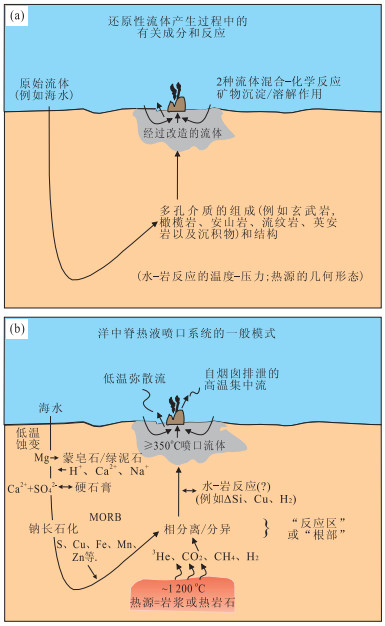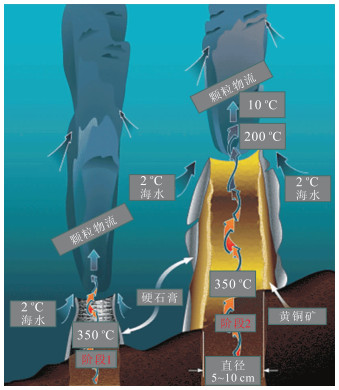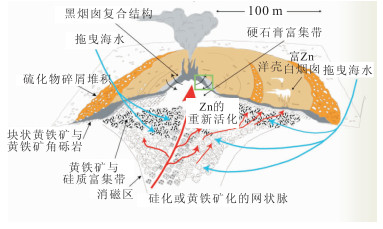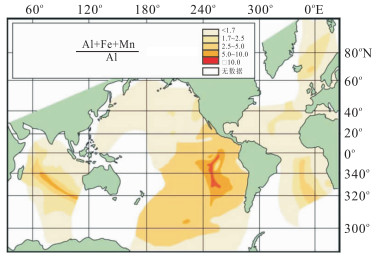Modern Seafloor Hydrothermal Processes and Mineralization
-
摘要: 原始的海水成分、基岩的组分及结构、热源性质等因素决定着现代海底热液喷口系统的流体成分, 同时, 各种地质构造背景下的岩浆脱气作用也在不同程度上影响热液流体的组成.热液流体一旦喷出海底, 就能形成不同类型的热液沉积体, 包括高温流体形成的金属硫化物或硫酸盐烟囱体、热液丘以及由低温弥散流及非浮力羽流形成的含金属沉积物堆积体.高温烟囱体的形成受控于海水和热液的混合比例, 常常表现为典型的两阶段模式, 即先形成环状硬石膏表层, 然后在其内部发生富Cu硫化物的沉淀.这一模式在更大尺度上也可以观察到, 如TAG热液丘.含金属沉积物遍布海底, 除热液羽流外, 金属硫化物烟囱体在氧化环境中氧化蚀变的产物也是其重要来源.生物的活动贯穿于现代热液过程的始终, 并在烟囱体的形成、分解以及羽流的扩散沉淀过程中起到了重要作用.当前, 热液生物矿化机理、Lost City型热液场以及超慢速扩张洋脊的有关研究是海底这一系统研究的热点, 前两者研究能使人们更好地理解地球早期的演化和生命的起源, 而后者的考察和研究能进一步丰富海底热液成矿理论, 并有助于寻找更大规模的热液矿体.Abstract: The composition of hot fluids that exit at vent fields reflects a number of factors including the initial seawater composition, the composition and structure of host rock, and the characteristics (depth, size, and shape) of heat source. Meanwhile, the addition of magmatic volatiles in various tectonic environments may affect fluid compositions. Two main types of hydrothermal deposits, including metal sulfide chimneys formed by high temperature fluid and the metalliferous sediments derived from hydrothermal plumes, diffuse flows and the mass wasting of preformed metal sulfides, may form when the vent flow rises from seafloor. The formation of sulfide chimneys is dominated by the mixing ratios of seawaters and hydrothermal fluids, and generally features with a typical two-stage-model. During stage 1, vent fluid mixes turbulently with seawater, resulting in precipitation of a ring of anhydrite. While in stage 2, the copper-iron, and iron sulfides begin to precipitate and plate the inner chimney wall. This model can also be observed on a larger scale, such as in TAG hydrothermal mounds. The biological processes are believed to play a key role in the hydrothermal mineralization including the formation and alteration of chimneys and diffusion of plumes. Nowadays, much attention is concentrated on the exploration and mineralization of Lost City field and ultraslow-spreading ridges. The researches of the first two issues may deepen the understandings of the early earth and life evolution, and the researches of the last one may enrich the mineralization theory and facilitate investigations of larger scale sulfide deposits.
-
图 1 影响洋壳内热液流体成分的各种过程与组成示意(a)和洋中脊系统喷口流体形成过程的详解(b)(据Tivey, 2007)
Fig. 1. Schematic drawing of a hydrothermal system within oceanic crust showing the different components and processes that can affect the composition of the fluid that vents at the seafloor (a), elaboration of the processes that contribute to formation of mid-ocean ridge vent fluids (b)
图 2 典型的热液烟囱体生长模式图(据Tivey, 1998)
Fig. 2. Typical growth model of hydrothermal chimney
图 3 TAG的热液丘体形成模式图(据Tivey, 2007)
Fig. 3. Growth model of the Trans-Atlantic Geotraverse (TAG) active hydrothermal mound
图 4 全球海底现代含金属沉积物分布(据Böstrom and Peterson, 1969)
上覆沉积物(Al+Fe+Mn)/Al比值高的地方是含金属沉积物最富集的地区
Fig. 4. Global distribution of metalliferous sediments
图 5 全球超慢速扩张洋脊分布(据Snow and Edmonds, 2007)
红色表示超慢速扩张洋脊;GR.哈克尔海岭(Gakkel Ridge);LT.勒拿海槽(Lena Trough);KR.克尼波维奇海岭(Knipovich Ridge);MR.莫恩斯海岭(Mohns Ridge);CT.开曼海沟(Cayman Trough);AAR.亚美利加-南极海岭(America-Antarctic Ridge);SWIR.西南印度洋脊(Southwest Indian Ridge);除MR与SWIR由作者自行翻译外,其余各洋脊或海槽的中文名称由金山爱词霸在线词典(http://www.iciba.com)提供
Fig. 5. Global plate boundaries (gray) and oceanic spreading ridge segments
-
Allen, D.E., Seyfried Jr, W.E., 2004. Serpentinization and Heat Generation: Constraints from Lost City and Rainbow Hydrothermal Systems. Geochimica et Cosmochimica Acta, 68(6): 1347-1354. doi: 10.1016/j.gca.2003.09.003 Alt, J.C., 1995. Subseafloor Processes in Mid-Ocean Ridge Hydrothermal Systems. In: Humphris, S.E., Zierenherg, R.A., Mullineaux, L.S., et al., eds., Seafloor Hydrothermal Systems: Physical, Chemical, Biological, and Geological Interactions. AGU, Monograph Series, 91: 85-114. Alt, J.C., Lanord, C.F., Floyd, P.A., et al., 1992. Low Temperature Hydrothermal Alteration of Jurassic Ocean Crust, Site 801. Proceedings of the Ocean Drilling Program, Scientific Results, 129: 415-427. http://www.researchgate.net/publication/235687674_Low-Temperature_Hydrothermal_Alteration_of_Jurassic_Ocean_Crust_Site_801 Bach, W., Banerjee, N.R., Dick, H.J.B., et al., 2002. Discovery of Ancient and Active Hydrothermal Systems along the Ultra-Slow Spreading Southwest Indian Ridge 10°-16°E. Geochemistry, Geophysics, Geosystems, 3(7): 1-14. doi: 10.1029/2001GC000279 Baker, E.T., Edmonds, H.N., Michael, P.J., et al., 2004. Hydrothermal Venting in Magma Deserts the Ultraslow-Spreading Gakkel and Southwest Indian Ridges. Geochemistry, Geophysics, Geosystems, 5(8): Q08002. doi: 10.1029/2004GC000712 Berndt, M.E., Seyfried, W.E., Janecky, D.R., 1989. Plagioclase and Epidote Buffering of Cation Ratios in Mid-Ocean Ridge Hydrothermal Fluids: Experimental Results in and near the Supercritical Region. Geochimica et Cosmochimica Acta, 53(9): 2283-2300. doi: 10.1016/0016-7037(89)90351-7 Böstrom, K., Peterson, M.N.A., 1969. The Origin of Aluminium-Poor Ferromanganoan Sediments in Areas of High Heat Flow on the East Pacific Rise. Marine Geology, 7(5): 427-447. doi: 10.1016/0025-3227(69)90016-4 Botz, R., Winckler, G., Bayer, R., et al., 1999. Origin of Trace Gases in Submarine Hydrothermal Vents of the Kolbeinsey Ridge, North Iceland. Earth and Planetary Science Letters, 171(1): 83-93. doi: 10.1016/S0012-821X(99)00128-4 Bradley, A.S., Hayes, J.M., Summons, R.E., 2009. Extraordinary 13C Enrichment of Diether Lipids at the Lost City Hydrothermal Field Indicates a Carbon-Limited Ecosystem. Geochimica et Cosmochimica Acta, 73(1): 102-118. doi: 10.1016/j.gca.2008.10.005 Bradley, A.S., Summons, R.E., 2010. Multiple Origins of Methane at the Lost City Hydrothermal Field. Earth and Planetary Science Letters, 297(1-2): 34-41. doi: 10.1016/j.epsl.2010.05.034 Charlou, J.L., Donval, J.P., Fouquet, Y., et al., 2002. Geochemistry of High H2 and CH4 Vent Fluids Issuing from Ultramafic Rocks at the Rainbow Hydrothermal Field (36°4′N, MAR). Chemical Geology, 191(4): 345-359. doi: 10.1016/S0009-2541(02)00134-1 Chavagnac, V., Palmer, M.R., Milton, A., et al., 2006. Hydrothermal Sediments as a Potential Record of Seawater Nd Isotope Compositions: The Rainbow Vent Site (36°14′N, Mid-Atlantic Ridge). Paleoceanography, 21: PA3012. doi: 10.1029/2006PA001273 Connelly, D.P., German, C.R., 2002. Total Dissolvable Manganese Anomalies over the Knipovich Ridge: Evidence for Hydrothermal Activity. EOS Transactions American Geophysical Union, 83(Supp. 4): OS205-206. http://eprints.soton.ac.uk/2214/ Cousens, B.L., Blenkinsop, J., Franklin, J.M., 2002. Lead Isotope Systematics of Sulfide Minerals in the Middle Valley Hydrothermal Systems, Northern Juan de Fuca Ridge. Geochemistry, Geophysics, Geosystems, 3(5): 1-16. doi: 10.1029/2001GC000257 Dekov, V.M., Kamenov, G.D., Savelli, C., et al., 2009. Metalliferous Sediments from Eolo Seamount (Tyrrhenian Sea): Hydrothermal Deposition and Re-Deposition in a Zone of Oxygen Depletion. Chemical Geology, 264(1-4): 347-363. doi: 10.1016/j.chemgeo.2009.03.023 Delacour, A., Früh-Green, G.L., Bernasconi, S.M., et al., 2008. Carbon Geochemistry of Serpentinites in the Lost City Hydrothermal System (30°N, MAR). Geochimica et Cosmochimica Acta, 72(15): 3681-3702. doi: 10.1016/j.gca.2008.04.039 Dias, Á. S., Barriga, F.J.A.S., 2006. Mineralogy and Geochemistry of Hydrothermal Sediments from the Serpentinite-Hosted Saldanha Hydrothermal Field (36°34′N; 33°26′W) at MAR. Marine Geology, 225(1-4): 157-175. doi: 10.1016/j.margeo.2005.07.013 Dick, G.J., Andersson, A.F., Baker, B.J., et al., 2009. Community-Wide Analysis of Microbial Genome Signatures. Genome Biology, 10: R85. doi: 10.1186/gb-2009-10-8-r85. Dick, J.B., Lin, J., Schouten, H., 2003. An Ultraslow-Spreading Class of Ocean Ridge. Nature, 426: 405-412. doi: 10.1038/nature02128 Douville, E., Bienvenu, P., Charlou, J.L., et al., 1999. Yttrium and Rare Earth Elements in Fluids from Various Deep-Sea Hydrothermal Systems. Geochimica et Cosmochimica Acta, 63(5): 627-643. doi: 10.1016/S0016-7037(99)00024-1 Duhig, N.C., Stolz, J., Davidson, G.J., et al., 1992. Cambrian Microbial and Silica Gel Textures in Silica Iron Exhalites from the Mount Windsor Volcanic Belt, Australia: Their Petrography, Chemistry, and Origin. Economic Geology, 87(3): 764-784. doi: 10.2113/gsecongeo.87.3.764 Edmonds, H.N., Michael, P.J., Baker, E.T., et al., 2003. Discovery of Abundant Hydrothermal Venting on the Ultraslow-Spreading Gakkel Ridge in the Arctic Ocean. Nature, 421: 252-256. doi: 10.1038/nature01351









 下载:
下载:



